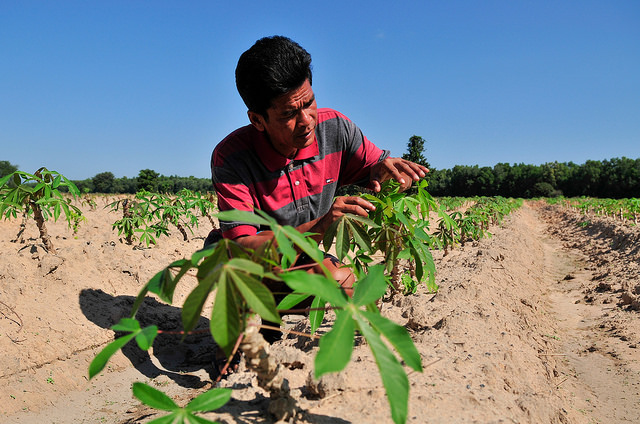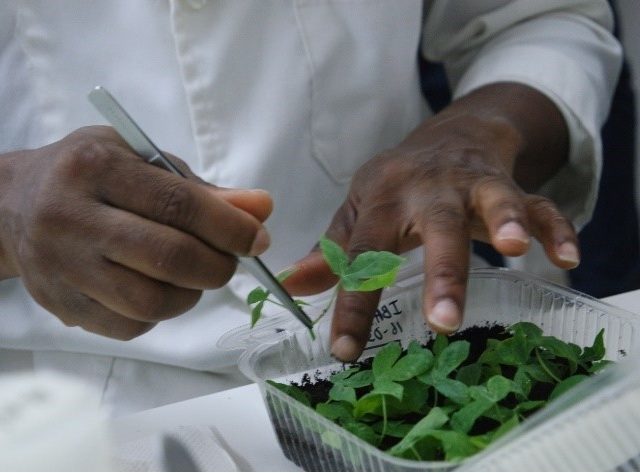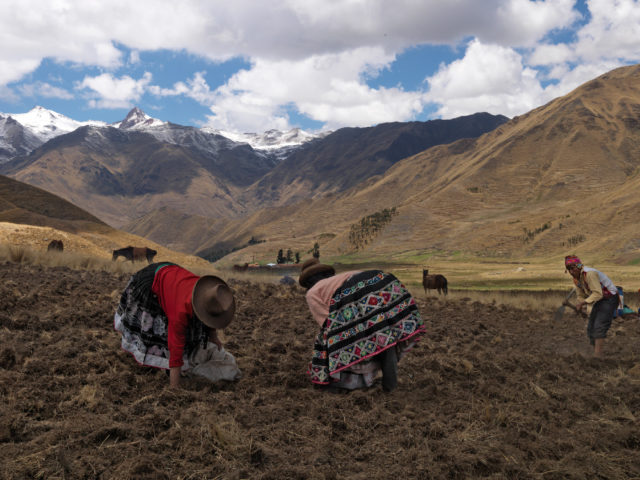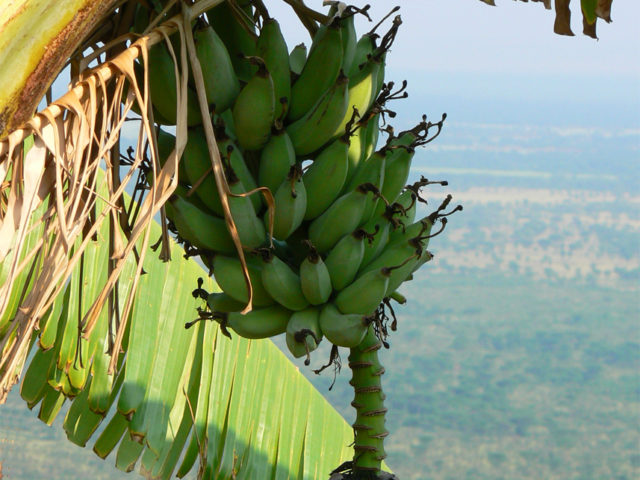Given its focus on the resilience of root, tuber and banana crops, Flagship Project 3 (FP3) aims to incorporate environmental, biological, ecological and economic considerations into the various ‘clusters’ – distinct projects within the flagship.
Crop resilience can be compromised in myriad ways, notes James Legg, FP3 leader and a plant virologist at the International Institute of Tropical Agriculture (IITA). Among them:
- Biological factors: including pests, diseases and the inevitable introduction of alien invasive species into a new geographical region as a function of increased international trade and people’s global movement patterns
- Environmental factors: ranging from drought and increased soil salinity to unexpected spikes or drops in temperature
- Agro-ecological factors: such as the over-exploitation of land through multiple cycles of cropping, which leads to soil degradation, nutrient deficiencies and other problems
- Social factors: T for example, population growth leading to greater pressure on agricultural land, or the impacts on shareholders of increasingly smaller farming plots
- Factors related to changing global climate: these effects will differ greatly among crops and could include shortened life cycles and increased economic damage from major pests.
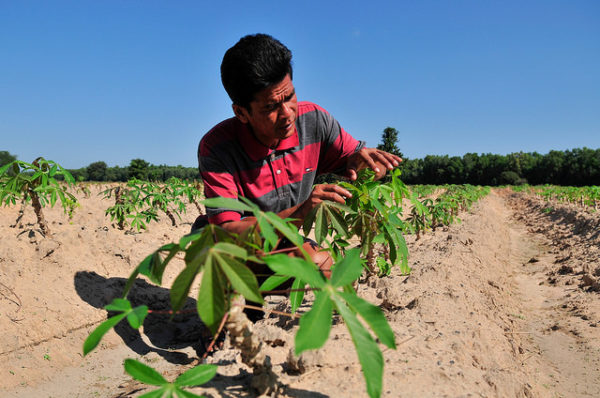
Cassava farmer examines his field infected by cassava witches’ broom disease in Cambodia. Photo G.Smith/CIAT
Across this array of threats to resilience, technology is vitally important for achieving the goals of FP3, Legg says. For example, sequencing DNA from a specific pest can help the team determine which species are present in which locations, leading to more precisely targeted control efforts.
Moreover, the ability to use new tools to diagnose a disease more quickly and cheaply goes a long way toward containing the threat it poses.
“The invasive pathogen Fusarium oxysporum fsp cubense – Tropical Race 4 – was detected for the first time on the African continent, in a single farm in Mozambique, through the use of a molecular diagnostic method using polymerase chain reaction (PCR),” Legg says. “FP3 scientists and their partners are now using these diagnostics in a containment programme that will map the geographic spread of this new pathogen prior to designing a comprehensive control strategy.”

Yellow and wilted leaves are typical symptoms of Fusarium wilt. Photo G.Blomme/Bioversity International
Sometimes, efforts to boost crop resilience occur in isolation from efforts to enhance other desirable traits. Yet that won’t always be the case: Legg observes that increasingly in Phase II, FPs will combine to “bring these two lines of work together so that improved nutritional profiles” – whose development IN orange-fleshed sweetpotato (OFSP), cassava and banana is being addressed in FP2 and FP4 – “will be combined with resistance to major biotic and abiotic threats in new varieties developed and promoted.” In fact there are multiple natural points of intersection among FP3’s focus on resilience and its sister flagships. By the same token, germplasm development work housed under FP2 will dovetail with specific clusters in FP3. In addition, FP3’s project to improve diagnosis and control using phytosanitation of banana bunchy top virus (BBTV) is being linked to other flagships to help scale up efforts to control its spread.
In theory, how long would it take for Legg and the rest of the FP3 team to ascertain if resilience has increased in a given crop? It all depends on the factors against which resilience is being gauged, he says.
For example, since FP3 covers much of RTB’s disease-management work, it might only require two or three growing seasons (ideally in different locations) to measure whether crops now display greater ability to withstand pest and disease pressures. Yet “for factors such as climate change or soil degradation, the period required may be longer,” he says.
“Much of the cross cutting thinking on resilience in FP3 is being undertaken within cluster 3.2, Sustainable Cropping Systems,” Legg continues. “Under this cluster, research is being undertaken that aims to develop resilient production systems. Since this work considers the whole system, with its diversity of crops and environments, there is an inherent complexity. This will mean that it will take several years before systems with enhanced resilience can be developed, and several more years before the robustness of those systems can be confirmed.”
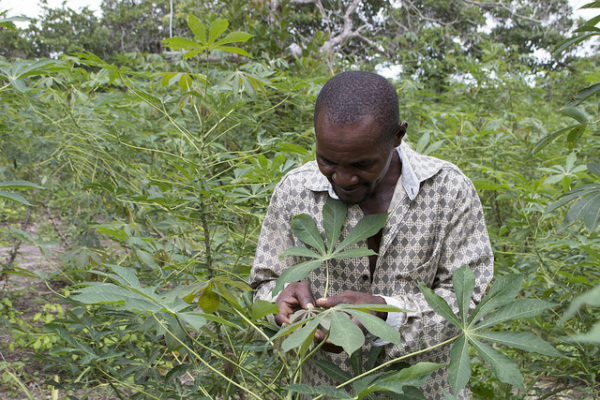
Cassava farmer, Mr. Khalifa Omari Nkrumah, of Mkurangra district, Tanzania inspects his cassava plants for the presence of Cassava Brown Streak Disease. Photo H.Holmes/RTB
As resilience increases, so too can smallholders’ potential economic and social benefits. Yet Legg cautions that there’s no quick path from greater resilience to greater revenue.
“Yield increases can be converted to estimates of economic gain and increased income,” he notes. “Calculating the impact at the community level is significantly more challenging, and requires the implementation of impact studies conducted at the community level both before baseline and after the implementation of resilience-promoting activities.” Typically speaking, community level change is achieved only after a meaningful period of scaling – which is where FP5 Improved Livelihoods at Scale will engage and support.
“The key theme unifying all of the FPs is the development of productive, profitable and sustainable systems that will ensure that roots, tubers and bananas make a major contribution to sustaining and enhancing the livelihoods of the growing number of people living in the tropical parts of the developing world,” Legg says. “In all the FPs, we share a common goal, and we are working closely together to achieve that.”
This is the third in a series of blogs showcasing the new Flagship Projects of the CGIAR Research Program on Roots, Tubers and Bananas. The next edition will examine Flagship 2 on ‘Adaptive Varieties and Quality Seed‘. By Amy Rogers Nazarov
